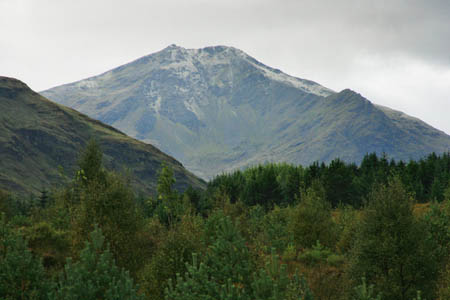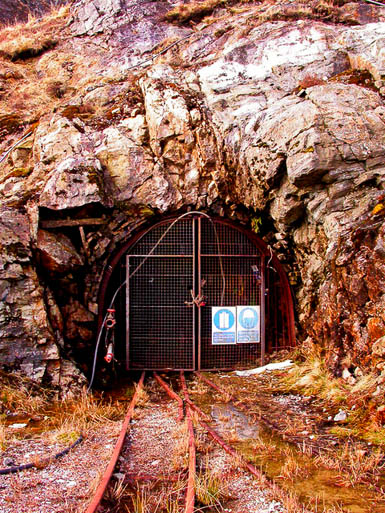
Ben Lui, the 28th highest munro and site of a classic winter climb up its central gully
A national park boss has recommended the reopening of a goldmine in the Highlands despite it being against the park authority’s landscape policy.
Gordon Watson of the Loch Lomond and the Trossachs National Park Authority said long-term benefits to the area around the Cononish mine outweigh the disruption for the 10 years the mine owners plan to operate.
Mr Watson, director of planning and rural development for the authority, made the recommendation after the original application by Scotgold Resources was turned down by national park bosses last year. The director’s u-turn came after assurances on restoring the area around the site near Tyndrum, in the shadow of munro Ben Lui.
The national park authority’s board will make a site visit in 10 days’ time and there will be a special meeting at Crianlarich to consider the plans, at which supporters and objectors will have their views heard.
The national park authority said the Australian mine applicants had pledged to carry out improvements in the Cononish Glen, including the planting of 25ha (62 acres) of native woodland, plus tree planting around the mine site at the foot of Beinn Chuirn.
Scotgold Resources estimates it can extract 21,000 ounces of gold and 83,000 ounces of silver from the mine each year, with most of the gold exported overseas for treatment, though a quarter of the precious metal would be smelted at the site.
The company has committed itself to a 30-year restoration plan, and some of the slurry produced – the ‘tailings’ – would be dried and reburied in the mine.
The authority said 50 conditions will be imposed if the application is approved. It also said the reopening of the mine would provide 52 jobs and an economic benefit to Scotland of more than £80m.
The value of gold anticipated to be extracted each year is more than £22m at today’s prices, though Scottish this could be higher as Scottish gold commands a premium price.
Mr Watson said: “On balance, I have concluded that the temporary adverse impacts are outweighed by the anticipated outcome of a higher quality landscape and recreational experience being delivered in the long term.
“This benefit is in addition to the considerable economic benefits likely to accrue both to the park area and wider Scottish economy. Critical to this is that the size, shape and contouring of the tailings management facility can be restored to appear as a natural feature in the landscape.
“It is a significant material consideration that, following mine restoration and a successfully delivered Greater Cononish Glen Management Plan – which includes areas of native woodland planting – there will be an improvement to the landscape and relative wildness of the area.”
Referring to the previously refused application last year, Mr Watson added: “I have greater confidence in the restoration techniques now being proposed and that, in combination with the smaller and more contoured form of the TMF and associated tree planting, the impacts of the mine will not be adverse following closure and restoration.
“It is important to note that I consider that the impacts and benefits associated with this development will have a favourable contribution to the national park aims over the medium to long term.”
Ben Lui, at 1,130m (3,707ft), is the 28th highest munro; the 880m (2,887ft) Beinn Chuirn is a corbett.

CL
14 October 2011Although I am an investor/speculator in metals mining and exploration, I find it almost astonishing that there is an intention to disturb a precious national site for so small a sum as 22M. If some improvements.
If the working adults were taxed or donated a few pence per year for the period you could have your improvements without the harm, which is generally underestimated.
Edweirdovich
15 October 201122 million per year x 10 years is a not insignificant 220 million quid. In this day and age every penny counts for the Scottish economy. The Scottish govt should take this over to stop the profits going to Oz. There are plenty more developments associated with this gold prospect which will increase the revenue...
"find it almost astonishing that there is an intention to disturb a precious national site"....obviously not been up there then, eh? Any development will be an improvement to the approach to Cononish never mind the new Native woodlands that will be magnificent.
CL must be short for clown i take it!
Colin Wells
16 October 2011Not much of a National Park if they put profits before protecting the landscape.
I wonder if Edweirdovich has really been up there? I doubt it - either that or went somewhere else by mistake, or was blindfolded at the time...
Make no mistake, this will be a major industrial development in a landscape that is already under severe potential threat from multi-national developers. I think most of us thought National park status might at least protect some areas from the onslaught of disfiguring developments currently assailing the Highlands
But no. Just as in the Cairngorms, where Johnny Grant has got the go-ahead to build his new town next to Aviemore with the blessing of Park planning authority, so now with Lomond & Trossachs. Scottish National Parks are beginning to look like a joke in very poor taste. Gawd help the areas outside - the gold-diggers have got their venal beady eyes on Beinn Udlaidh next...
Oakley X Squared Ice
08 May 2015Awsome info and straight to the point. I dont know if this is actually the best place to ask but do you folks have any ideea where to get some professional writers? Thank you :)
Nike Air Yeezy 2 Pčervenáaj
03 June 2015Tack för att skriva den här artikeln så tydlig terminologi. Du är bra med denna typ av innehåll och jag håller med dina unika tankar.